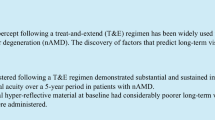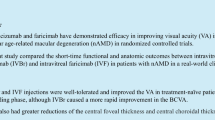Abstract
Background
To compare possible toxic effects of membrane blue and infracyanine green used as vital stains in macular surgery. Vital stains are used in vitreoretinal surgery to perform peeling of the internal limiting membrane and idiopathic epiretinal membrane. There are many controversial studies about their toxicity, safety, and their effects on the retinal pigment epithelium and the neuroretinal elements. To compare possible toxicities of the two vital stains membrane blue and infracyanine green in vivo, we conducted a prospective, randomized, clinical trial.
Methods
A prospective, randomized clinical trial including 30 eyes of 30 patients with either full-thickness macular hole or idiopathic epiretinal membrane were included and randomized 1:1 to receive either membrane blue or infracyanine green during vitreoretinal surgery. Complete ophthalmic examinations, including optical coherence tomography and peripheral visual field were performed preoperatively, and 1, 3, and 6 months postoperatively in our clinic. The main outcome measure was the peripheral visual field. Data was analysed with Student’s t-test and Pearson’s correlation coefficient.
Results
Three months after surgery there was a significant difference in increase in visual field in the superior region in favor of the membrane blue group (p = 0.021). Eight eyes (53%) of the infracyanine group had a decrease in temporal visual fields of at least 5°.
Conclusion
Although there was a significant difference in visual fields between the groups after 3 months in the superior region, there were no more significant differences between the two groups after 6 months. However, due to the decrease in the temporal visual field in some eyes, we conclude that membrane blue is less toxic.


Similar content being viewed by others
References
Gass JD (1988) Idiopathic senile macular hole. Its early stages and pathogenesis. Arch Ophthalmol 106:629–639
Mitchell P, Smith W, Chey T, Wang JJ, Chang A (1997) Prevalence and associations of epiretinal membranes. The Blue Mountains Eye Study, Australia. Ophthalmology 104:1033–1040
Kodjikian L, Richter T, Halberstadt M, Beby F, Flueckiger F, Boehnke M, Garweg JG (2005) Toxic effects of indocyanine green, infracyanine green, and trypan blue on the human retinal pigmented epithelium. Graefes Arch Clin Exp Ophthalmol 243:917–925
Teba FA, Mohr A, Eckardt C, Wong D, Kusaka S, Joondeph BC, Feron EJ, Stalmans P, Van Overdam K, Melles GR (2003) Trypan blue staining in vitreoretinal surgery. Ophthalmology 110:2409–2412
Jackson TL, Hillenkamp J, Knight BC, Zhang JJ, Thomas D, Stanford MR, Marshall J (2004) Safety testing of indocyanine green and trypan blue using retinal pigment epithelium and glial cell cultures. Invest Ophthalmol Vis Sci 45:2778–2785
Gandorfer A, Haritoglou C, Gandorfer A, Kampik A (2003) Retinal damage from indocyanine green in experimental macular surgery. Invest Ophthalmol Vis Sci 44:316–323
Funahashi T (1980) The vital staining of the eye (author's transl). Nippon Ganka Gakkai Zasshi 84:1826–1880
Li K, Wong D, Hiscott P, Stanga P, Groenewald C, McGalliard J (2003) Trypan blue staining of internal limiting membrane and epiretinal membrane during vitrectomy: visual results and histopathological findings. Br J Ophthalmol 87:216–219
Rezai KA, Farrokh-Siar L, Gasyna EM, Ernest JT (2004) Trypan blue induces apoptosis in human retinal pigment epithelial cells. Am J Ophthalmol 138:492–495
Haritoglou C, Eibl K, Schaumberger M, Mueller AJ, Priglinger S, Alge C, Kampik A (2004) Functional outcome after trypan blue-assisted vitrectomy for macular pucker: a prospective, randomized, comparative trial. Am J Ophthalmol 138:1–5
Iriyama A, Uchida S, Yanagi Y, Tamaki Y, Inoue Y, Matsuura K, Kadonosono K, Araie M (2004) Effects of indocyanine green on retinal ganglion cells. Invest Ophthalmol Vis Sci 45:943–947
Gass CA, Haritoglou C, Schaumberger M, Kampik A (2003) Functional outcome of macular hole surgery with and without indocyanine green-assisted peeling of the internal limiting membrane. Graefes Arch Clin Exp Ophthalmol 241:716–720
Uemura A, Kanda S, Sakamoto Y, Kita H (2003) Visual field defects after uneventful vitrectomy for epiretinal membrane with indocyanine green-assisted internal limiting membrane peeling. Am J Ophthalmol 136:252–257
Kanda S, Uemura A, Yamashita T, Kita H, Yamakiri K, Sakamoto T (2004) Visual field defects after intravitreous administration of indocyanine green in macular hole surgery. Arch Ophthalmol 122:1447–1451
Hillenkamp J, Saikia P, Herrmann WA, Framme C, Gabel VP, Sachs HG (2007) Surgical removal of idiopathic epiretinal membrane with or without the assistance of indocyanine green: a randomised controlled clinical trial. Graefes Arch Clin Exp Ophthalmol 245:973–979
Nagai N, Ishida S, Shinoda K, Imamura Y, Noda K, Inoue M (2007) Surgical effects and complications of indocyanine green-assisted internal limiting membrane peeling for idiopathic macular hole. Acta Ophthalmol Scand 85:883–889
Engelbrecht NE, Freeman J, Sternberg P Jr, Aaberg TM Sr, Aaberg TM Jr, Martin DF, Sippy BD (2002) Retinal pigment epithelial changes after macular hole surgery with indocyanine green-assisted internal limiting membrane peeling. Am J Ophthalmol 133:89–94
Jackson TL, Vote B, Knight BC, El-Amir A, Stanford MR, Marshall J (2004) Safety testing of infracyanine green using retinal pigment epithelium and glial cell cultures. Invest Ophthalmol Vis Sci 45:3697–3703
Haritoglou C, Gandorfer A, Schaumberger M, Tadayoni R, Gandorfer A, Kampik A (2003) Light-absorbing properties and osmolarity of indocyanine-green depending on concentration and solvent medium. Invest Ophthalmol Vis Sci 44:2722–2729
Gass JD (1995) Reappraisal of biomicroscopic classification of stages of development of a macular hole. Am J Ophthalmol 119:752–759
la Cour M, Friis J (2002) Macular holes: classification, epidemiology, natural history and treatment. Acta Ophthalmol Scand 80:579–587
Treatment of age-related macular degeneration with photodynamic therapy (TAP) Study Group (1999) Photodynamic therapy of subfoveal choroidal neovascularization in age-related macular degeneration with verteporfin: one-year results of 2 randomized clinical trials—TAP report. Arch Ophthalmol 117:1329–1345
Radner W, Obermayer W, Richter-Mueksch S, Willinger U, Velikay-Parel M, Eisenwort B (2002) The validity and reliability of short German sentences for measuring reading speed. Graefes Arch Clin Exp Ophthalmol 240:461–467
Brooks HL Jr (2000) Macular hole surgery with and without internal limiting membrane peeling. Ophthalmology 107:1939–1948 discussion 1948–1949
Sivalingam A, Eagle RC Jr, Duker JS, Brown GC, Benson WE, Annesley WH Jr, Federman J (1990) Visual prognosis correlated with the presence of internal-limiting membrane in histopathologic specimens obtained from epiretinal membrane surgery. Ophthalmology 97:1549–1552
Schumann RG, Gandorfer A, Priglinger SG, Kampik A, Haritoglou C (2009) Vital dyes for macular surgery: a comparative electron microscopy study of the internal limiting membrane. Retina 29:669–676
Hillenkamp J, Saikia P, Gora F, Sachs HG, Lohmann CP, Roider J, Baumler W, Gabel VP (2005) Macular function and morphology after peeling of idiopathic epiretinal membrane with and without the assistance of indocyanine green. Br J Ophthalmol 89:437–443
Feldman A, Zerbib J, Glacet-Bernard A, Haymann P, Soubrane G (2008) Clinical evaluation of the use of infracyanine green staining for internal limiting membrane peeling in epimacular membrane surgery. Eur J Ophthalmol 18:972–979
Yam HF, Kwok AK, Chan KP, Lai TY, Chu KY, Lam DS, Pang CP (2003) Effect of indocyanine green and illumination on gene expression in human retinal pigment epithelial cells. Invest Ophthalmol Vis Sci 44:370–377
Costa Ede P, Rodrigues EB, Farah ME, Dib E, Penha F, Magalhaes O Jr, Furlani BA, Lima Filho AA, de Miranda A, Maia M (2009) Vital dyes and light sources for chromovitrectomy: comparative assessment of osmolarity, pH, and spectrophotometry. Invest Ophthalmol Vis Sci 50:385–391
Farah ME, Maia M, Rodrigues EB (2009) Dyes in ocular surgery: principles for use in chromovitrectomy. Am J Ophthalmol 148:332–340
Rodrigues EB, Meyer CH, Mennel S, Farah ME (2007) Mechanisms of intravitreal toxicity of indocyanine green dye: implications for chromovitrectomy. Retina 27:958–970
Veckeneer M, van Overdam K, Monzer J, Kobuch K, van Marle W, Spekreijse H, van Meurs J (2001) Ocular toxicity study of trypan blue injected into the vitreous cavity of rabbit eyes. Graefes Arch Clin Exp Ophthalmol 239:698–704
Yan H, Dhurjon L, Chow DR, Williams D, Chen JC (1998) Visual field defect after pars plana vitrectomy. Ophthalmology 105:1612–1616
Boldt HC, Munden PM, Folk JC, Mehaffey MG (1996) Visual field defects after macular hole surgery. Am J Ophthalmol 122:371–381
Orellana J, Lieberman RM (1993) Stage III macular hole surgery. Br J Ophthalmol 77:555–558
Henrich PB, Haritoglou C, Meyer P, Ferreira PR, Schotzau A, Katamay R, Josifova T, Schneider U, Flammer J, Priglinger S (2009) Anatomical and functional outcome in brilliant blue G assisted chromovitrectomy. Acta Ophthalmol Apr 23 [Epub ahead of print]
Mennel S, Meyer CH, Schmidt JC, Kaempf S, Thumann G (2008) Trityl dyes patent blue V and brilliant blue G—clinical relevance and in vitro analysis of the function of the outer blood-retinal barrier. Dev Ophthalmol 42:101–114
Luke M, Januschowski K, Beutel J, Luke C, Grisanti S, Peters S, Jaissle GB, Bartz-Schmidt KU, Szurman P (2008) Electrophysiological effects of Brilliant Blue G in the model of the isolated perfused vertebrate retina. Graefes Arch Clin Exp Ophthalmol 246:817–822
Enaida H, Hisatomi T, Goto Y, Hata Y, Ueno A, Miura M, Kubota T, Ishibashi T (2006) Preclinical investigation of internal limiting membrane staining and peeling using intravitreal brilliant blue G. Retina 26:623–630
Rodrigues EB, Penha FM, Farah ME, de Paula Fiod Costa E, Maia M, Dib E, Bottos J, Freymuller E, Furlani B, Meyer CH, Magalhaes O Jr, Lima-Filho AA, Safatle A (2009) Preclinical investigation of the retinal biocompatibility of six novel vital dyes for chromovitrectomy. Retina 29:497–510
Yuen D, Gonder J, Proulx A, Liu H, Hutnik C (2009) Comparison of the in vitro safety of intraocular dyes using two retinal cell lines: a focus on brilliant blue G and indocyanine green. Am J Ophthalmol 147(251–259):e252
Smiddy WE, Maguire AM, Green WR, Michels RG, de la Cruz Z, Enger C, Jaeger M, Rice TA (1989) Idiopathic epiretinal membranes. Ultrastructural characteristics and clinicopathologic correlation. Ophthalmology 96:811–820 discussion 821
Koizumi H, Spaide RF, Fisher YL, Freund KB, Klancnik JM Jr, Yannuzzi LA (2008) Three-dimensional evaluation of vitreomacular traction and epiretinal membrane using spectral-domain optical coherence tomography. Am J Ophthalmol 145:509–517
Acknowledgement
We would like to thank Astrid Kuersten for assistance with the Goldmann kinetic perimetry.
Author information
Authors and Affiliations
Corresponding author
Additional information
Financial relationships: None.
The authors have full control of all primary data, and agree to allow Graefe's Archive for Clinical and Experimental Ophthalmology to review data upon request.
Clinical trial was registered at http://www.clilnicaltrials.gov under NCT00555269.
Rights and permissions
About this article
Cite this article
Schmid-Kubista, K.E., Lamar, P.D., Schenk, A. et al. Comparison of macular function and visual fields after membrane blue or infracyanine green staining in vitreoretinal surgery. Graefes Arch Clin Exp Ophthalmol 248, 381–388 (2010). https://doi.org/10.1007/s00417-009-1213-4
Received:
Accepted:
Published:
Issue Date:
DOI: https://doi.org/10.1007/s00417-009-1213-4




